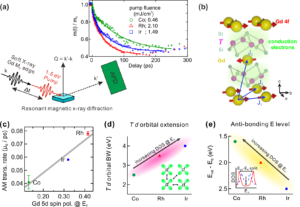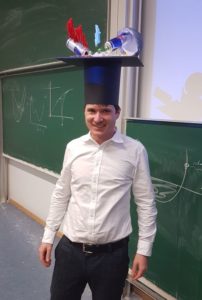Home
Welcome to the Dynamics of Correlated Materials group!
We are an experimental research group focusing on the investigation of ultrafast processes in strongly correlated materials. Our goal is the understanding of the fundamental interactions at play on the microscopic level in such materials, leading to complex behavior. We develop and employ complementary ultrafast techniques such as time- and angle-resolved photoelectron spectroscopy (trARPES) and time-resolved diffraction techniques to study those elementary interaction processes and couplings across ultrafast phase transitions.
News
Research unit OPTIMAL funded
Jan 2025

Ultrafast control of macroscopic properties of quantum materials through light-matter interaction is a promising avenue for condensed-matter research. The tremendous progress in the past decade brought key challenges that require collaborative efforts and new assets to face them. The assets are both the development of experimental techniques for nonequilibrium physics and the advancement in understanding how Floquet physics and strong light-matter coupling can provide new powerful means for control.
The newly funded research unit OPTIMAL – Optical Control of Quantum Materials has started its work on this.
Visit the project website for more information: OPTIMAL Website
New preprint: Controlling 4f antiferromagnetic dynamics via itinerant electronic susceptibility
Apr 2024

Lanthanide antiferromagnets are of strong interest in materials science due to their exceptionally large 4f magnetic moments leading to potential applications in high-density memory devices. Since the 4f moments are spatially localized, their ordering occurs indirectly by spin-polarizing itinerant conduction electrons via the indirect RKKY exchange interaction. The strength of this RKKY exchange has been directly linked to the ultrafast angular momentum transfer rate between antiferromagnetic sublattices. Despite this progress, the role of the microscopic ingredients to the RKKY interaction (on-site 4f orbital overlap and itinerant spin polarization) remains elusive up to now.
In our preprint, we systematically investigate the influence of itinerant conduction electrons on the RKKY exchange and ultrafast angular momentum transfer in a series of 4f antiferromagnetic intermetallics. By independently [more...]
In our preprint, we systematically investigate the influence of itinerant conduction electrons on the RKKY exchange and ultrafast angular momentum transfer in a series of 4f antiferromagnetic intermetallics. By independently [more...]
New paper published: Coherent Light Control of a Metastable Hidden State
Nov 2023

Active control over macroscopic properties of solids is highly desirable for a broad range of applications. A promising pathway to on-demand material properties are metastable hidden states, which are nonequilibrium phases that can only be reached after a quench by ultrashort optical or electrical pulses. As hidden states often host new emergent properties and can be switched on ultrafast timescales through non-thermal reaction pathways, they offer exciting novel functionalities for solid-state quantum devices. Yet, the fundamental processes that govern the dynamical pathway to hidden phases remain a largely open subject. Thus, switching is mostly based on empirical protocols, resulting in low efficiencies and limited control over stability.
In our recent study (Science Advances 9, 47, adi4661 (2023)), we investigate the dynamical pathway to the metastable hidden [more...]
In our recent study (Science Advances 9, 47, adi4661 (2023)), we investigate the dynamical pathway to the metastable hidden [more...]
Thesis defended: Julian Maklar
Apr 2023

Julian has defended his thesis with distinction. Congratulations and all the best for your future!
New paper: Orbital-resolved movie of exciton splitting
Apr 2023

Singlet fission may boost photovoltaic efficiency by transforming a singlet exciton into two triplet excitons and thereby doubling the number of excited charge carriers. The primary step of singlet fission has been disputed for decades and several mechanisms have been proposed. Using time- and angle-resolved photoemission spectroscopy, we record an ultrafast movie of the formation and fission of excitons in crystalline pentacene. Our results reveal the orbital character of the excited states providing unprecedented insight into the mechanism of the singlet fission process.
Neef et al., Nature 616, 275 (2023). See also related News & Views by Musser and Stern.
Neef et al., Nature 616, 275 (2023). See also related News & Views by Musser and Stern.